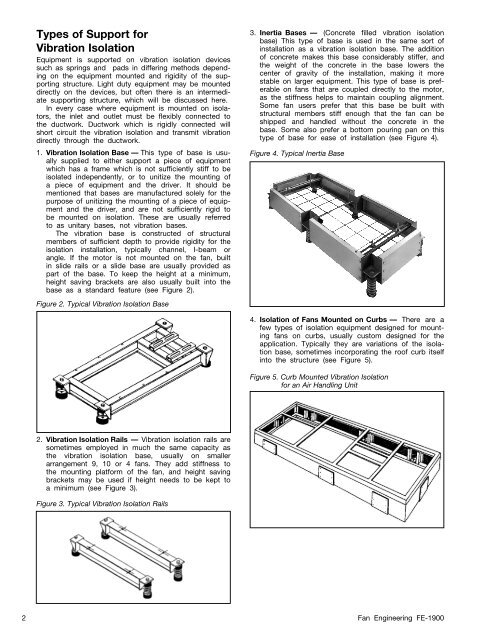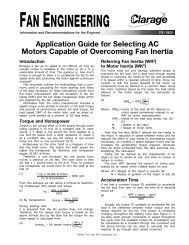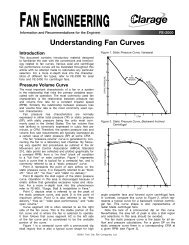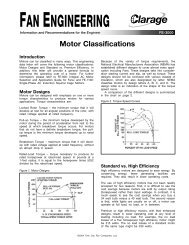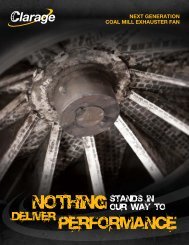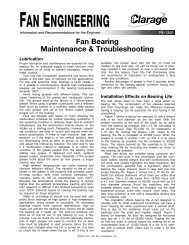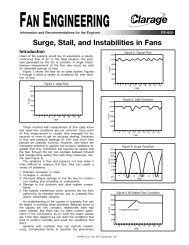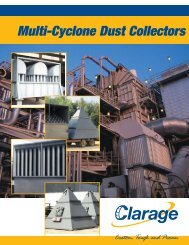Vibration Isolation of Fans - Clarage
Vibration Isolation of Fans - Clarage
Vibration Isolation of Fans - Clarage
Create successful ePaper yourself
Turn your PDF publications into a flip-book with our unique Google optimized e-Paper software.
Types <strong>of</strong> Support for<br />
<strong>Vibration</strong> <strong>Isolation</strong><br />
Equipment is supported on vibration isolation devices<br />
such as springs and pads in differing methods depending<br />
on the equipment mounted and rigidity <strong>of</strong> the supporting<br />
structure. Light duty equipment may be mounted<br />
directly on the devices, but <strong>of</strong>ten there is an intermediate<br />
supporting structure, which will be discussed here.<br />
In every case where equipment is mounted on isolators,<br />
the inlet and outlet must be flexibly connected to<br />
the ductwork. Ductwork which is rigidly connected will<br />
short circuit the vibration isolation and transmit vibration<br />
directly through the ductwork.<br />
1. <strong>Vibration</strong> <strong>Isolation</strong> Base — This type <strong>of</strong> base is usually<br />
supplied to either support a piece <strong>of</strong> equipment<br />
which has a frame which is not sufficiently stiff to be<br />
isolated independently, or to unitize the mounting <strong>of</strong><br />
a piece <strong>of</strong> equipment and the driver. It should be<br />
mentioned that bases are manufactured solely for the<br />
purpose <strong>of</strong> unitizing the mounting <strong>of</strong> a piece <strong>of</strong> equipment<br />
and the driver, and are not sufficiently rigid to<br />
be mounted on isolation. These are usually referred<br />
to as unitary bases, not vibration bases.<br />
The vibration base is constructed <strong>of</strong> structural<br />
members <strong>of</strong> sufficient depth to provide rigidity for the<br />
isolation installation, typically channel, I-beam or<br />
angle. If the motor is not mounted on the fan, built<br />
in slide rails or a slide base are usually provided as<br />
part <strong>of</strong> the base. To keep the height at a minimum,<br />
height saving brackets are also usually built into the<br />
base as a standard feature (see Figure 2).<br />
Figure 2. Typical <strong>Vibration</strong> <strong>Isolation</strong> Base<br />
3. Inertia Bases — (Concrete filled vibration isolation<br />
base) This type <strong>of</strong> base is used in the same sort <strong>of</strong><br />
installation as a vibration isolation base. The addition<br />
<strong>of</strong> concrete makes this base considerably stiffer, and<br />
the weight <strong>of</strong> the concrete in the base lowers the<br />
center <strong>of</strong> gravity <strong>of</strong> the installation, making it more<br />
stable on larger equipment. This type <strong>of</strong> base is preferable<br />
on fans that are coupled directly to the motor,<br />
as the stiffness helps to maintain coupling alignment.<br />
Some fan users prefer that this base be built with<br />
structural members stiff enough that the fan can be<br />
shipped and handled without the concrete in the<br />
base. Some also prefer a bottom pouring pan on this<br />
type <strong>of</strong> base for ease <strong>of</strong> installation (see Figure 4).<br />
Figure 4. Typical Inertia Base<br />
4. <strong>Isolation</strong> <strong>of</strong> <strong>Fans</strong> Mounted on Curbs — There are a<br />
few types <strong>of</strong> isolation equipment designed for mounting<br />
fans on curbs, usually custom designed for the<br />
application. Typically they are variations <strong>of</strong> the isolation<br />
base, sometimes incorporating the ro<strong>of</strong> curb itself<br />
into the structure (see Figure 5).<br />
Figure 5. Curb Mounted <strong>Vibration</strong> <strong>Isolation</strong><br />
for an Air Handling Unit<br />
2. <strong>Vibration</strong> <strong>Isolation</strong> Rails — <strong>Vibration</strong> isolation rails are<br />
sometimes employed in much the same capacity as<br />
the vibration isolation base, usually on smaller<br />
arrangement 9, 10 or 4 fans. They add stiffness to<br />
the mounting platform <strong>of</strong> the fan, and height saving<br />
brackets may be used if height needs to be kept to<br />
a minimum (see Figure 3).<br />
Figure 3. Typical <strong>Vibration</strong> <strong>Isolation</strong> Rails<br />
2 Fan Engineering FE-1900


